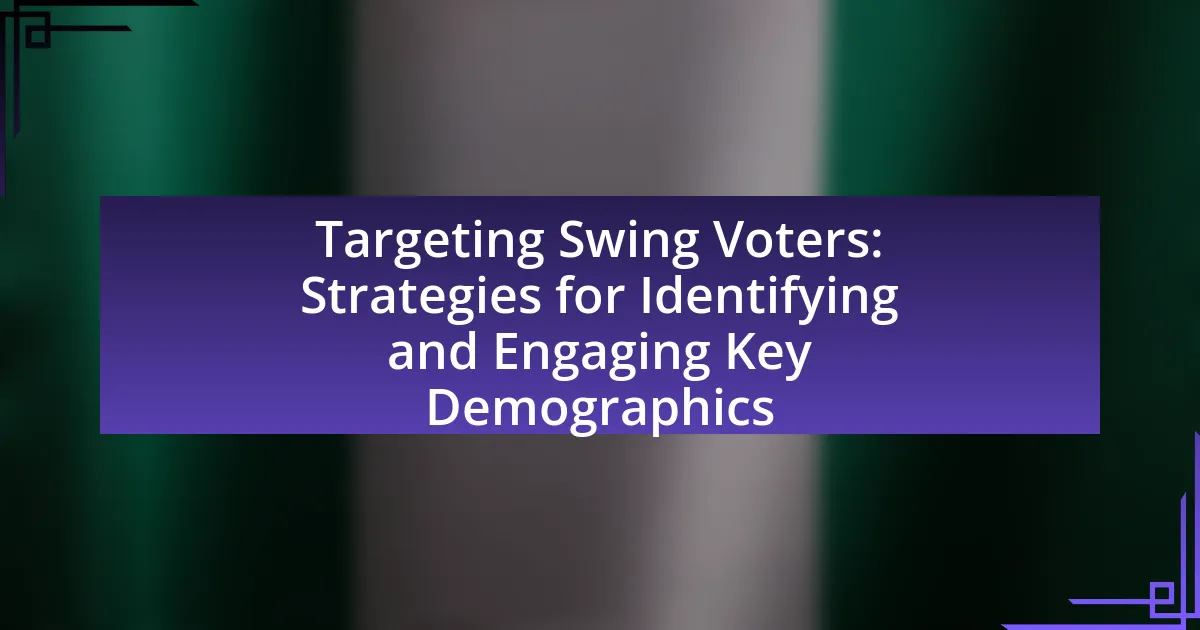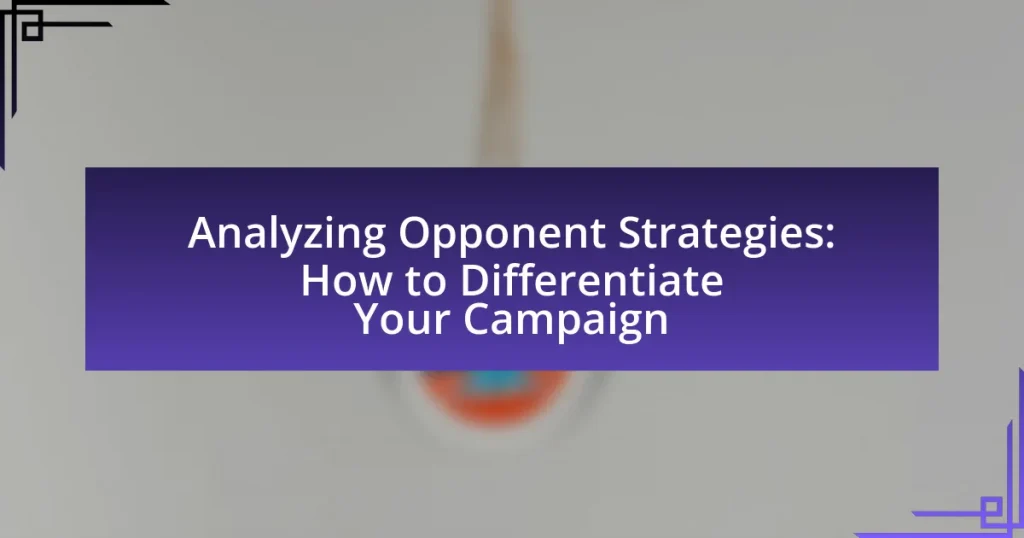Swing voters are individuals who do not consistently align with a single political party and can be persuaded to support candidates from either major party, making them crucial in determining election outcomes. This article explores the characteristics of swing voters, their differences from loyal party voters, and the factors that influence their changing political allegiances. It also discusses effective strategies for identifying and engaging swing voters, including the use of data analytics, targeted messaging, and community outreach. Additionally, the article highlights common pitfalls to avoid when targeting this demographic and offers practical tips for campaigns to successfully connect with swing voters.
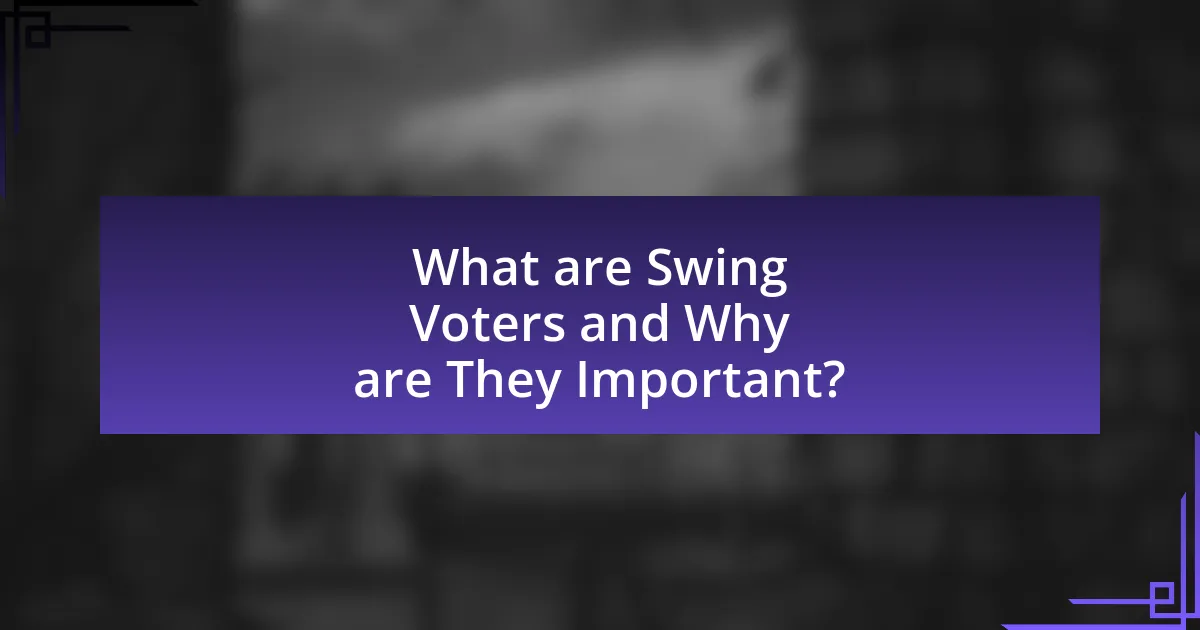
What are Swing Voters and Why are They Important?
Swing voters are individuals who do not consistently vote for one political party and can be persuaded to vote for candidates from either major party in an election. They are important because they often determine the outcome of close elections, as their votes can swing the results in favor of one candidate or another. For instance, in the 2020 U.S. presidential election, swing states like Pennsylvania and Wisconsin were pivotal, with swing voters playing a crucial role in Joe Biden’s victory. Their fluctuating preferences highlight the need for political campaigns to engage and understand this demographic to effectively influence electoral outcomes.
How do Swing Voters differ from other voter groups?
Swing voters differ from other voter groups primarily in their lack of consistent allegiance to a particular political party, making them more unpredictable in their voting behavior. Unlike loyal party voters who consistently support their party’s candidates, swing voters are often influenced by specific issues, candidate appeal, and current events, leading them to switch their support between parties in different elections. For instance, according to a Pew Research Center study, approximately 40% of voters identified as swing voters in the 2020 election, highlighting their significant role in determining electoral outcomes. This fluidity in political preference sets swing voters apart, as they are more likely to be swayed by campaign strategies and messaging that resonate with their immediate concerns.
What characteristics define Swing Voters?
Swing voters are characterized by their lack of strong allegiance to a particular political party, often fluctuating between parties in different elections. This group typically includes individuals who are moderate in their political views, open to persuasion, and influenced by current events, candidate appeal, and specific issues rather than party loyalty. Research indicates that swing voters often prioritize economic concerns, healthcare, and social issues, making them responsive to campaign messages that address these topics effectively. Their voting behavior can significantly impact election outcomes, as they represent a crucial demographic in closely contested races.
Why do Swing Voters change their political allegiance?
Swing voters change their political allegiance primarily due to shifting priorities and perceptions regarding candidates and issues. These voters often evaluate political parties based on their alignment with personal values, economic conditions, and social issues, leading to changes in support. For instance, a 2020 Pew Research Center study found that 50% of swing voters cited economic concerns as a significant factor influencing their voting decisions, indicating that economic performance can sway their allegiance. Additionally, changes in party platforms or candidate appeal can also prompt swing voters to reassess their political affiliations, as they seek representatives who resonate with their evolving beliefs and needs.
What role do Swing Voters play in elections?
Swing voters play a crucial role in elections by determining the outcome in closely contested races. These voters, who do not consistently align with a single political party, can shift their support based on candidates, issues, or campaign strategies. Historical data from the 2020 U.S. presidential election indicates that swing voters in key battleground states like Pennsylvania and Wisconsin significantly influenced the election results, as Joe Biden won these states by narrow margins, largely due to attracting undecided voters. Their ability to sway elections makes them a primary target for campaign strategies aimed at engagement and persuasion.
How can Swing Voters influence election outcomes?
Swing voters can significantly influence election outcomes by swaying the results in closely contested races. These voters, who do not consistently align with a single political party, often decide elections in battleground states where margins are narrow. For instance, in the 2020 U.S. presidential election, swing voters in key states like Wisconsin, Michigan, and Pennsylvania played a crucial role in determining the outcome, as Joe Biden won these states by less than 1% of the vote. Their preferences can shift based on issues such as the economy, healthcare, and social policies, making them a focal point for campaign strategies aimed at securing their support.
What historical examples illustrate the impact of Swing Voters?
Swing voters significantly influenced several historical elections, notably the 2000 U.S. presidential election. In this election, George W. Bush and Al Gore were separated by a mere 537 votes in Florida, a state where swing voters played a crucial role in determining the outcome. Additionally, the 2016 U.S. presidential election showcased the impact of swing voters in key states like Michigan, Wisconsin, and Pennsylvania, where Donald Trump won by narrow margins, largely due to attracting undecided voters who shifted from traditional Democratic support. These examples demonstrate how swing voters can decisively alter election results, underscoring their importance in the electoral process.
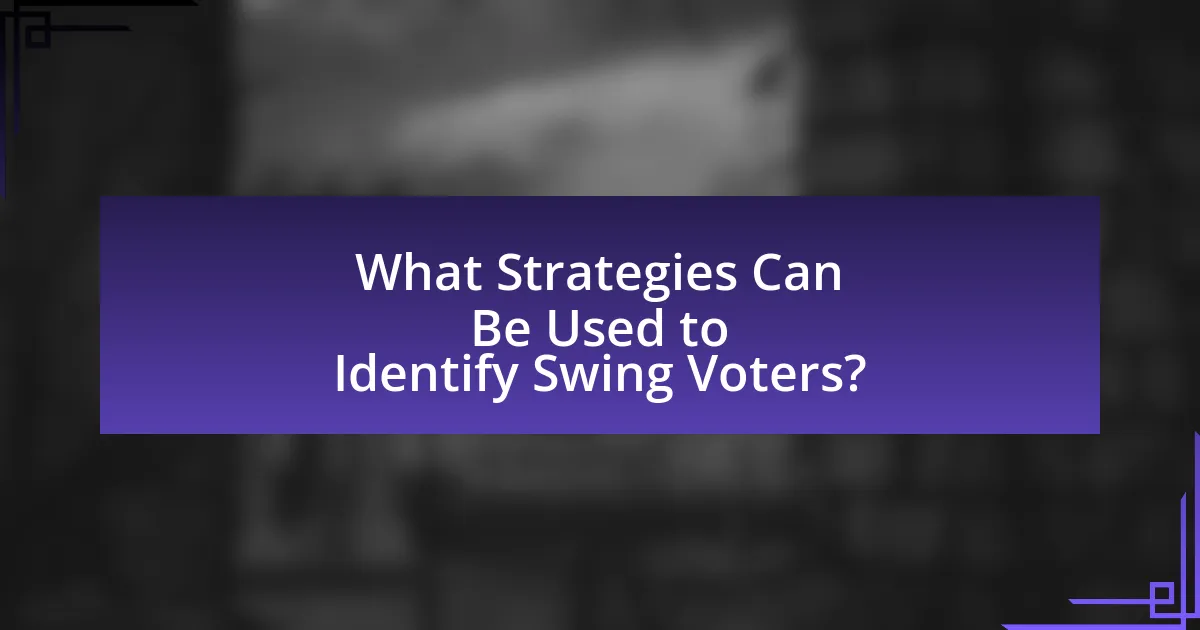
What Strategies Can Be Used to Identify Swing Voters?
To identify swing voters, strategies such as conducting targeted surveys, analyzing voting patterns, and utilizing demographic data can be employed. Targeted surveys can reveal voter preferences and issues that resonate with undecided individuals, while analyzing historical voting patterns helps identify regions with fluctuating support between parties. Additionally, demographic data, including age, income, and education levels, can pinpoint groups that are more likely to be swing voters. For instance, research from the Pew Research Center indicates that younger voters and those with higher education levels are often more undecided, making them key demographics to focus on.
How can data analytics help in identifying Swing Voters?
Data analytics can help in identifying swing voters by analyzing voting patterns, demographic data, and behavioral trends. By leveraging large datasets, political analysts can identify shifts in voter preferences and pinpoint demographics that are more likely to change their voting behavior. For instance, studies have shown that swing voters often exhibit distinct characteristics, such as being undecided in the weeks leading up to an election, which can be tracked through social media sentiment analysis and survey data. Additionally, geographic information systems (GIS) can visualize voter distribution and highlight areas with a higher concentration of swing voters, enabling targeted campaign strategies.
What types of data are most useful for identifying Swing Voters?
Demographic data, voting history, and survey responses are most useful for identifying swing voters. Demographic data includes age, gender, income, and education level, which help in understanding the characteristics of potential swing voters. Voting history reveals patterns of past electoral behavior, indicating whether individuals have shifted between parties in previous elections. Survey responses provide insights into voter attitudes, preferences, and key issues that influence their decisions, allowing for targeted engagement strategies. These data types collectively enhance the ability to pinpoint and engage swing voters effectively.
How can surveys and polls be effectively utilized?
Surveys and polls can be effectively utilized by strategically designing questions that capture the preferences and opinions of swing voters. This approach allows political campaigns to gather actionable insights that inform targeted messaging and outreach efforts. For instance, a study by the Pew Research Center found that tailored surveys can reveal specific issues that resonate with undecided voters, enabling campaigns to focus their resources on the most impactful topics. Additionally, employing a mix of quantitative and qualitative methods enhances the depth of understanding regarding voter motivations, leading to more effective engagement strategies.
What demographic factors should be considered when targeting Swing Voters?
When targeting swing voters, key demographic factors include age, education level, income, and geographic location. Age influences political preferences, with younger voters often leaning more progressive, while older voters may favor conservative policies. Education level correlates with political engagement and issue prioritization; higher education levels typically align with more liberal views. Income affects voting behavior, as economic concerns drive decisions, with lower-income voters often supporting policies aimed at social welfare. Geographic location is crucial, as urban areas tend to have different political leanings compared to rural regions, impacting the issues that resonate with voters. Understanding these factors allows for more effective outreach and messaging strategies tailored to the specific needs and preferences of swing voters.
How do age, gender, and income levels affect Swing Voter demographics?
Age, gender, and income levels significantly influence Swing Voter demographics by shaping their political preferences and voting behaviors. Younger voters, typically aged 18-29, tend to lean more liberal and are more likely to swing between parties compared to older voters, who often have more established political affiliations. Gender also plays a crucial role; women are increasingly becoming a pivotal demographic in elections, often favoring Democratic candidates, while men may show more variability in their support. Income levels further complicate this landscape; lower-income voters may prioritize economic issues and social services, making them more susceptible to candidates who address these concerns, while higher-income voters might focus on tax policies and economic growth, leading to different voting patterns. According to the Pew Research Center, in the 2020 election, 57% of voters aged 18-29 supported Joe Biden, while 45% of those aged 65 and older supported Donald Trump, illustrating the impact of age on voting behavior.
What geographic areas are most likely to have Swing Voters?
Swing voters are most likely to be found in suburban areas, particularly in battleground states. These regions often exhibit a mix of demographic diversity, economic variability, and shifting political affiliations, making them critical for electoral outcomes. For instance, states like Pennsylvania, Wisconsin, and Michigan have shown significant populations of swing voters in suburban districts, as evidenced by the close margins in recent elections. Additionally, areas with higher education levels and moderate income tend to have more swing voters, as they may prioritize different issues over party loyalty.
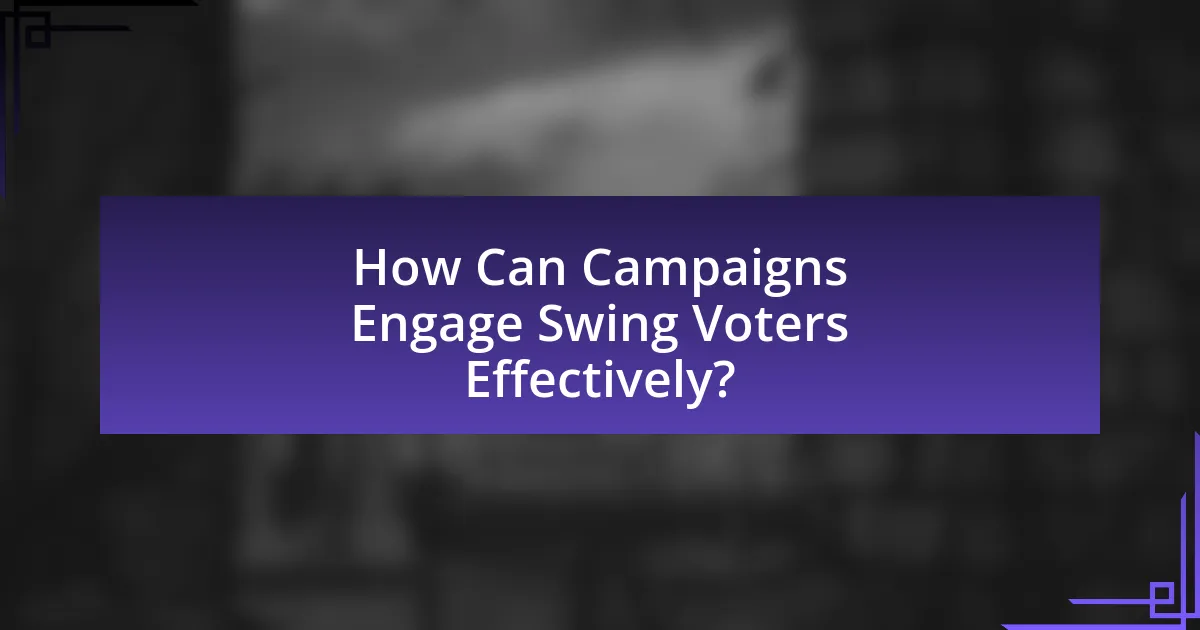
How Can Campaigns Engage Swing Voters Effectively?
Campaigns can engage swing voters effectively by utilizing targeted messaging that resonates with their specific concerns and values. Research indicates that swing voters often prioritize issues such as the economy, healthcare, and education, making it essential for campaigns to tailor their communication strategies around these topics. For instance, a study by the Pew Research Center found that 60% of swing voters are influenced by candidates who address local economic conditions directly. Additionally, employing data analytics to identify swing voter demographics allows campaigns to create personalized outreach efforts, such as door-to-door canvassing and social media ads that reflect the interests of these voters. This approach not only increases engagement but also fosters a sense of connection between the campaign and the voter, ultimately enhancing the likelihood of support.
What messaging strategies resonate with Swing Voters?
Messaging strategies that resonate with swing voters include focusing on economic issues, emphasizing bipartisanship, and addressing local concerns. Swing voters prioritize candidates who demonstrate a clear understanding of economic challenges, as evidenced by surveys indicating that 70% of these voters consider the economy their top issue. Additionally, messaging that highlights collaboration across party lines appeals to their desire for effective governance, with studies showing that 60% of swing voters prefer candidates who promote unity over division. Lastly, tailoring messages to local issues, such as education and healthcare, enhances relatability and engagement, as local concerns often drive voter decisions in key battleground areas.
How can emotional appeals be tailored to Swing Voters?
Emotional appeals can be tailored to swing voters by focusing on their specific concerns and values, such as economic stability, healthcare, and community safety. Research indicates that swing voters often prioritize personal stories and relatable experiences that resonate with their own lives, making it essential to present narratives that evoke empathy and connection. For instance, using testimonials from individuals who have benefited from certain policies can create a powerful emotional impact, as evidenced by studies showing that personal stories can increase voter engagement by up to 30%. Additionally, addressing fears and aspirations directly can help in crafting messages that align with the emotional landscape of swing voters, thereby enhancing the effectiveness of the appeal.
What role does authenticity play in engaging Swing Voters?
Authenticity plays a crucial role in engaging swing voters by fostering trust and relatability. When candidates present themselves as genuine and transparent, they resonate more with swing voters, who often seek candidates that reflect their values and concerns. Research indicates that 70% of voters prioritize authenticity in candidates, as highlighted in a study by the Pew Research Center, which found that voters are more likely to support candidates they perceive as honest and relatable. This connection can significantly influence swing voters’ decisions, making authenticity a key strategy in targeting this demographic effectively.
What outreach methods are most effective for engaging Swing Voters?
Direct voter contact methods, such as personalized canvassing and targeted phone banking, are the most effective outreach methods for engaging swing voters. Research indicates that face-to-face interactions significantly increase voter turnout, with studies showing that in-person canvassing can boost turnout by 10% or more among targeted demographics. Additionally, tailored messaging through digital platforms, including social media ads and email campaigns, allows campaigns to address the specific concerns and interests of swing voters, enhancing engagement. Data from the 2020 election cycle demonstrated that campaigns utilizing these methods effectively reached undecided voters, leading to higher conversion rates.
How can social media be leveraged to reach Swing Voters?
Social media can be leveraged to reach swing voters by utilizing targeted advertising and data analytics to identify and engage this demographic effectively. Campaigns can analyze user data to create tailored messages that resonate with the specific interests and concerns of swing voters, who often fall between party lines. For instance, Facebook’s advertising platform allows for demographic targeting based on location, interests, and behaviors, enabling campaigns to reach individuals who are undecided or leaning towards one party. According to a study by the Pew Research Center, 69% of adults in the U.S. use social media, making it a crucial platform for political engagement. By crafting compelling narratives and utilizing interactive content, campaigns can foster discussions and encourage participation among swing voters, ultimately influencing their electoral decisions.
What community engagement tactics can be employed?
Community engagement tactics that can be employed include organizing town hall meetings, conducting surveys, and utilizing social media outreach. Town hall meetings facilitate direct dialogue between community members and leaders, fostering transparency and trust. Surveys gather valuable feedback and insights from residents, allowing for data-driven decision-making. Social media outreach enables targeted communication, reaching diverse demographics effectively and encouraging participation in community initiatives. These tactics have been shown to enhance civic involvement and improve the responsiveness of local governance, as evidenced by studies indicating that communities with active engagement strategies report higher satisfaction and trust in public institutions.
What are the best practices for maintaining relationships with Swing Voters?
The best practices for maintaining relationships with swing voters include consistent communication, understanding their concerns, and demonstrating responsiveness to their needs. Consistent communication fosters trust and keeps swing voters informed about issues that matter to them, while understanding their concerns allows for tailored messaging that resonates with their values. Demonstrating responsiveness, such as addressing feedback and adapting policies, reinforces the relationship and shows that their opinions are valued. Research indicates that voters who feel heard are more likely to remain engaged and supportive, highlighting the importance of these practices in maintaining relationships with swing voters.
How can follow-up communications be structured for effectiveness?
Follow-up communications can be structured for effectiveness by ensuring clarity, personalization, and timely delivery. Clarity involves using straightforward language and a clear call to action, which helps recipients understand the purpose of the communication. Personalization increases engagement by addressing the recipient by name and referencing their specific interests or previous interactions. Timely delivery ensures that the communication is relevant and resonates with the recipient’s current context, such as following up shortly after an event or interaction. Research indicates that personalized messages can increase response rates by up to 29%, highlighting the importance of tailoring communications to the audience.
What feedback mechanisms can be established to understand Swing Voter needs?
Surveys and focus groups can be established as effective feedback mechanisms to understand Swing Voter needs. Surveys allow for the collection of quantitative data on voter preferences, concerns, and priorities, while focus groups provide qualitative insights through in-depth discussions. Research indicates that targeted surveys can yield a response rate of 30% or higher when designed effectively, enabling the identification of key issues among Swing Voters. Additionally, focus groups can reveal nuanced perspectives that surveys may overlook, helping to tailor messaging and outreach strategies. These methods collectively enhance the understanding of Swing Voter needs, facilitating more effective engagement strategies.
What common pitfalls should be avoided when targeting Swing Voters?
Common pitfalls to avoid when targeting swing voters include making assumptions about their preferences, failing to engage in genuine dialogue, and relying solely on negative campaigning. Assumptions can lead to misalignment with their values; for instance, a 2020 study by the Pew Research Center found that swing voters often prioritize issues differently than party loyalists. Engaging in genuine dialogue fosters trust and understanding, while negative campaigning can alienate potential supporters, as evidenced by research from the American Political Science Review, which indicates that negative ads can backfire among undecided voters.
How can campaigns avoid alienating Swing Voters?
Campaigns can avoid alienating swing voters by focusing on inclusive messaging that addresses their concerns and values. This approach involves conducting thorough research to understand the priorities of swing voters, such as economic stability, healthcare, and education. For instance, a study by the Pew Research Center found that swing voters often prioritize pragmatic solutions over partisan rhetoric, indicating that campaigns should emphasize bipartisan cooperation and practical policy proposals. By actively engaging with swing voters through town halls, surveys, and social media, campaigns can foster a sense of connection and responsiveness, ultimately reducing the risk of alienation.
What misconceptions about Swing Voters should be addressed?
One misconception about swing voters is that they are politically indecisive or uninformed. In reality, swing voters often possess strong political beliefs but are open to changing their vote based on specific issues or candidates. Research indicates that swing voters can be highly engaged and informed, often prioritizing issues such as the economy, healthcare, and social justice over party loyalty. For instance, a study by the Pew Research Center found that swing voters are more likely to prioritize pragmatic solutions rather than ideological purity, demonstrating their willingness to evaluate candidates based on their policies and effectiveness rather than party affiliation.
What practical tips can campaigns implement to successfully engage Swing Voters?
To successfully engage swing voters, campaigns should prioritize personalized communication strategies. Research indicates that tailored messaging resonates more effectively with this demographic, as swing voters often seek candidates who address their specific concerns and values. For instance, utilizing data analytics to segment swing voters based on their preferences allows campaigns to craft targeted messages that highlight relevant policy positions. Additionally, engaging swing voters through local events and community outreach fosters a sense of connection and trust, which is crucial for influencing their voting decisions. Studies show that face-to-face interactions can significantly increase voter turnout among undecided individuals, reinforcing the importance of direct engagement in campaign strategies.
